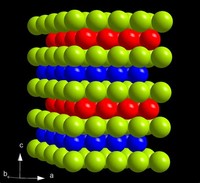Facts about Curium

A rare earth homolog, curium is somewhat chemically similar to gadolinium but with a more complex crystal structure.

Curium (chemical symbol Cm, atomic number 96) is a radioactive, metallic, transuranic element of the actinide series.

Curium is an inner transition metal of the actinide series, located in period seven of the periodic table, between americium and berkelium.

Other curium isotopes (Cu-243, Cu-244) are also being investigated for their potential as fuels for RTGs.

The isotope curium-248 has been synthesized only in milligram quantities, but curium-242 and curium-244 are made in multigram amounts, which allows for the determination of some of the element's properties.

Curium-242 is the precursor to plutonium-238, which is the most common fuel for RTGs.

Curium-242 can generate up to 120 watts of thermal energy per gram (W/g).

Chemically reactive, its metal is silvery-white in color and the element is more electropositive than aluminum (most trivalent curium compounds are slightly yellow).

Curium-243, with a roughly 30-year half-life and good energy density (about 1.6 W/g), would seem to make an ideal fuel, but it produces significant amounts of gamma and beta radiation from radioactive decay products.

The isotope curium-242 is the precursor to plutonium-238, the most common fuel for radioisotope thermoelectric generators (RTGs) that have been used to power certain space probes.

Curium-244 can be made in quantity by subjecting plutonium to neutron bombardment.

Curium was first synthesized at the University of California, Berkeley by Glenn T. Seaborg, Ralph A. James, and Albert Ghiorso in 1944.

Curium bio-accumulates in bone tissue where its radiation destroys bone marrow and thus stops the production of red blood cells.

Curium has been studied extensively as a potential fuel for Radioisotope thermoelectric generators that could be used to power space probes.

The isotopes of curium range in atomic weight from 233.051 amu (Cm-233) to 252.085 amu (Cm-252).

The isotope curium-242 (half-life 163 days) was made by bombarding a plutonium-239 target with alpha particles in the 60-inch cyclotron at Berkeley.

Louis Werner and Isadore Perlman created a visible sample of curium-242 hydroxide at the University of California in 1947 by bombarding americium-241 with neutrons.

